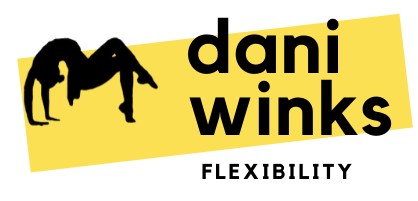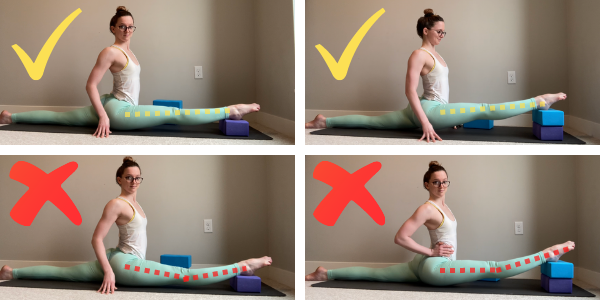When (and How) to Start Working on Oversplits
When (and How) to Start Working on Oversplits
While oversplit training may look like exercises reserved for those who are currently extremely comfortable in their flat splits, it’s actually safe an effective for students who are still an inch or two away from flat splits (and can even be a sneaky tool to help you close those last couple of inches!).
“Oversplits,” splits where your hips are open wider than 180 degrees, are usually trained with the support of yoga bocks under the front, back, or both legs, to increase the range of motion in hamstrings and hip flexors.
So let’s talk about who should incorporate oversplits into their training, and how to safely start working on oversplits without over-taxing your knees!
When to add oversplits to your training
Oversplit-type exercises are good for:
Students who already have a flat split and want to go deeper
Students who are 1-2 inches away from a flat split and are trying to finally get crotch touchdown
Students with strong splits (flat or close to flat, like above) who need active flexibility to be able to support their body weight in a split in the air, like in a split in aerial silks
If you meet the criteria above, then by all means start adding in some oversplit training to your regular splits training!
If you are still more than a couple of inches away from the floor in your splits, it’s going to be difficult to maintain proper form (which can be more harmful than helpful). Sticking to other active flexibility exercises like low lunge knee taps will help work on the strength and flexibility required for oversplits, but in a more appropriate range of motion for your current flexibility level.
How to start working on oversplits
Should you be elevating your back foot? Front foot? Does it matter where you put the block?
Yes, yes, and yes!
Block Under the Back Foot = Formidable Hip Flexors
I always like starting my oversplit work with a block under the back foot because this helps target the hip flexors (the front of the back-leg hip) which are usually the “weak point” in most people’s splits. Plus it just feels harder, so it’s nice to get the “hard stuff” out of the way first!
Place a block under the top of your back foot and slide out into a split. Remember to keep your torso lifted! If you lean forwards and let your pelvis tilt you’re going to take away the hip flexor stretch the block will add (so don’t be afraid to keep blocks under your hands if your hands don’t reach the floor).
Start with a couple of knee-straightens on the back leg to get used to the added hip flexor stretch (and the quad engagement needed to straighten the back leg). Aim for 5-10 knee straightens, then hold your back leg straight (knee lifted, quads super engaged), for 10 seconds. As you get stronger and more flexible, you can increase the duration of your back leg oversplit hold to 30 seconds (or even up to a minute, but personally I usually don’t do more than 30 seconds).
If you notice your front knee hyperextending (bending past 180 degrees) when you try to do your knee lifts, you may want prop up that knee with another yoga block, or a rolled up towel.
Block Under the Front Foot = Hardy Hamstrings
This is the position most people think of when they think of “oversplits” - elevating the front leg.
Block placement matters. Because this one can add more pressure to the front knee, I suggest starting with the block under your front calf instead of your foot to take some of the strain off of the knee joint. Over time as you get stronger you can work the block further out to your foot for your oversplit holds.
To help train your body for the quad engagement to protect your front knee in oversplits, I suggest starting with some leg straightens with a block under your front thigh or knee. Slide out into a split and put a block under your thigh near your knee, keeping your knee slightly bent and foot on the floor. Then engage your quads to straighten your front leg, as if trying to lift your foot off the floor (depending on your flexibility, your foot might lift, or it might just feel like a quad squeeze). The taller the block, the easier it is to lift the foot, so feel free to start on the highest or medium height setting. Aim for 5-10 foot lifts.
hen reach forward to move/adjust the block to slide it under your front calf, lightly engage your quads (about 50% of the squeeze you were doing in the previous exercise) and sink into your oversplit with the block supporting your front leg. Hold your front leg oversplit for 10-30 seconds.
Block Under Both Legs = Double Duty!
If/when you can get your hips flat on the ground during either of the exercises above, you can either add a block (so two blocks under the leg), or you can start working on double oversplits with blocks under both legs. Just like with the front leg oversplits, placing the front block closer to your knee can be “gentler” on your knee, and closer to your foot can require some additional quad engagement to protect the knee. So choose a position that feels challenging, but sustainable for a 20-30 second hold.
Example Oversplit Stretching Routine
I like to save working on my oversplits for after I’ve done a warm up and all my regular hip conditioning and pre-split prep (if you’re not sure where to start, this is an abridged version of my typical front splits routine). Then when it comes time for my splits holds, I do:
30 seconds with a block under the back foot (knee straightens then hold)
30 seconds with a block under the front foot (knee straightens then hold)
30 seconds with no blocks (or if you have a comfortable flat split, 30 seconds with blocks under both legs)
One Final Note: Protecting Your Knees in Oversplits
The most important thing to be aware of when working on oversplits is keeping your knees safe and happy. If this is the first time you’re working on oversplits, lifting your front foot and/or calf away from the floor can put a lot of pressure on your front knee, causing it to hyperextend (extend past it’s normal 180 degree range of motion).
Letting our knees knees flop into hyper extension in a weight-bearing position like a split puts more pressure on the ligaments in the knee, making them work overtime to protect the joint in a range of motion they aren’t the best suited to support. So to protect our front knee, we want to be sure to engage our quads to help prevent that knee from falling into hyperextension.
This is often easier to do before you sink into your deepest split - so as you are slowly lowering your hips, engage your front leg quads as if you are pulling your knee cap up your thigh toward your hip, and keep that quad engagement as you continue to lower. Don’t let your front knee sink lower than your thigh - you can keep more weight in your hands for support if you need to.
If you’re still struggling to keep your front knee from hyper extending, place a rolled up yoga mat or towel (squishy, but supportive) under that knee for some physical support as you condition your muscles to help support this new position.












